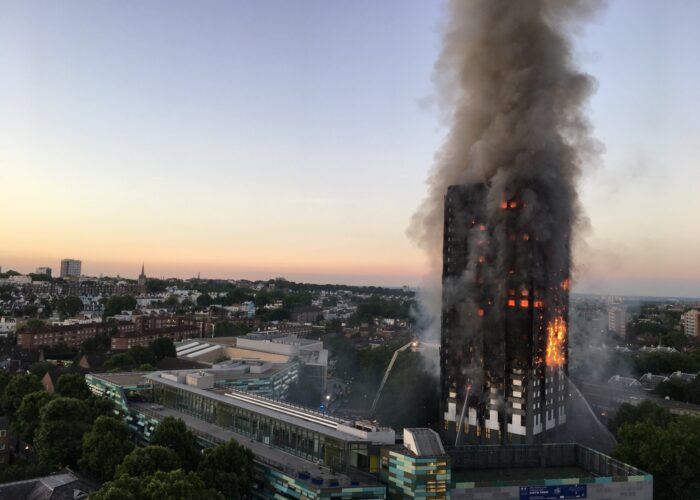
People living in buildings with unsafe cladding have been left in limbo.
That is the view of residents and campaigners dismayed by what they see as a lack of support and transparency from the government and housing developers.
The first inquest report into the Grenfell Tower fire, that claimed 72 lives in 2017, showed that the flammable cladding encasing the building was the major cause of the rapid spread of the fire.
The UK Government set up the £1 billion Building Safety Fund last year to help get unsafe cladding removed from buildings. However, demand for the fund has far exceeded the money available and applications could only be made from 31 July last year through to the end of 2020. There were also restrictions on who could apply to the fund with only buildings 18 metres or taller eligible.
In Liverpool, 50 buildings applied for the fund although, according to Julie Fraser, head of the cladding campaign group Liverpool Cladiators, the government hasn’t released specific data about the number of buildings that may be affected.
She said: “If the government are aware about how many buildings are actually affected, which you would like to think that they would be, they certainly aren’t passing the data on to anybody. Nobody can get the true figures.”
Ms Fraser explained that membership in her campaign group has doubled from early December from 80 to 159 as more of those affected seek answers.
For those leaseholders affected by the cladding crisis, the costs associated can be crippling. Ms Fraser, who has an apartment at the Deck in Runcorn, found that her insurance bills have risen dramatically. She said: “It’s dreadful, we received our insurance premium three weeks ago and it was £524,000 so since 2019 it’s increased by 1400%.
“For most people with a two bedroom apartment, bear in mind the service charge from two years ago was £251 per quarter, we’re going to have to pay anywhere between £500 and £600 per month”
Several buildings have had to bring in a waking watch to mitigate fire safety issues. This consists of a team of night watchmen to keep an eye on properties in case a fire breaks out. This service is expensive, in many cases as much as £300 per resident per month.
According to a statement on Twitter from MP for Liverpool Riverside, Kim Johnson, at least 25 buildings in Merseyside currently have a waking watch.
I didn’t get called today in the cladding scandal debate forced by the Labour Party. This is the speech I would have made in defence of hundreds of my constituents trapped in buildings that have become a nightmare and not the safe home they deserve. pic.twitter.com/2v16hhOaS6
— Kim Johnson MP (@KimJohnsonMP) February 1, 2021
These bills mixed with the fact the property they own is now essentially unsellable means there are now many leaseholders facing financial ruin.
“There’s a guy at the Deck, who’s going through the process of bankruptcy. There are many, many stories out there of people who are starting that.” Julie Fraser, Liverpool Cladiators.
This week, a £30 million fund has been made available for owners to install proper fire alarm systems so that a waking watch is not required.
Housing Secretary Robert Jenrick said: “We know many people are anxious about the costs of waking watches, which was always only intended as an interim measure while historic safety issues were fixed. This fund will relieve the financial pressure on residents in these buildings and ensure they will be kept safe.”
In Liverpool this fund is only £500,000 and, according to Councillor Barry Kushner, Liverpool City Council’s Cabinet member for Housing, comes up short. He said: “The fact that leaseholders have been paying for waking watches since the Grenfell Tower tragedy is a national disgrace. Although I welcome this new fund, I am concerned that it is just not enough.”
The cost of repairs is usually beyond leaseholders as the removal of cladding runs in to tens of thousands of pounds and estimates from the New Build Database and the Office for National Statistics suggests the cladding scandal could be even larger than previously thought, affecting as many as 11 million people. This means that any long-term solution will require further government intervention.
The Labour Party put forward and passed a motion last week to help fix the crisis, which would consist of setting up immediate funding for removing cladding and other fire safety work, protecting leaseholders and taxpayers by pursuing those responsible for the cladding scandal for costs and stamping out rogue builders by reforming the sector. As the government abstained on the vote, and there is no requirement for an opposition motion to pass into law, it seems unlikely that it will go any further.
Meanwhile there has been some willingness from certain developers to help with the situation. Barratt Homes have said they would be willing to pay a levy to help cover the cost of repairs. Chief executive David Thomas said: “We recognise how distressing this situation is for affected homeowners and we do not think they should have to pay for cladding to be removed from their buildings.
“While this is a hugely complex situation with many parties involved, we believe that housebuilders and the broader industry have a collective responsibility to be a part of the solution.”
View this post on Instagram

